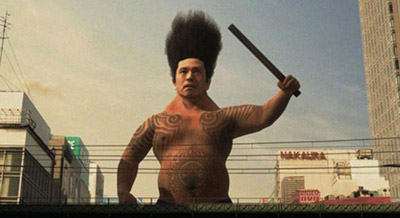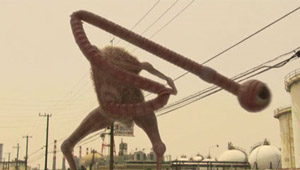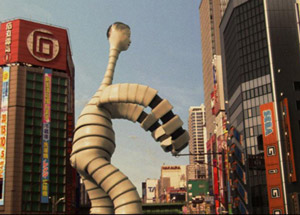Someone recommended the movie Big Man Japan (2007) to me out of the blue. I’d never heard of it, but I was told that I would probably enjoy it. Yesterday I gave it a watch, and it was far from what I expected.
The film follows a “common” Japanese man. A film crew is conducting a series of interviews as he goes about his normal daily activities. He’s struggling to make rent, separated from his wife, and only gets to see his daughter once a month. He’s somber and contemplative.
Oh yeah — he also tends to grow into a 50-foot mutated version of himself to fight off enormous invading monsters, protecting his fellow citizens from the monster threat.

The film catches the “King of Pain,” as he is nicknamed, on a sort of downward spiral. He comes from a long line of this kind of fighters — his father, grandfather, great grandfather, etc., were all giant monster fighters. In the past decades, they were highly respected, achieving fame and fortune as protectors. However, he has come to be shunned by the Japanese, and can’t seem to do anything right. It’s obvious that he’s depressed, and the desire to continue fighting is lost by the end, in which he slips into a weird delirium fueled by alcohol and disillusionment.
This movie is mostly done in the style of a reality/documentary film, but the fighting scenes are all cinematic. Apparently, his fights are televised, and the sponsors are paying the Big Man’s salary. Of course, all the monsters (including the giant King of Pain himself) are all done using CG — not with rubber suits, like I expected. Well, until the end, anyhow.
The CG worked for me. This may be surprising to you, being that I’m generally turned off by CG. The reason is that it wasn’t trying to pass computer-generated animation as real. The filmmakers didn’t attempt to combine live shots with CG. It gave a real fantasy quality to the fighting scenes.
Even more importantly is that this is a spoof. It’s making fun of traditional giant monster movies, exploring the element of the common man dealing with giant monsters. It’s yet another reason why the CG works — it’s not serious at all, despite the fact that there are some serious moments in the film (depression, divorce, etc.).
The monsters are highly original. The screeching, elastic monster with a combover. The monster whose single giant eye is attached via a very long umbilical cord. The passive monster who does nothing except block traffic and emit strange smells. I loved them all!


Some short-attention-span viewers of Big Man Japan will be driven crazy by the pacing. It’s slow and thoughtful, characteristic of a lot of Asian films. Moments are drawn out in a poetic way, leaving the viewer to dwell on the implications of the scene. The viewer is encouraged to drawn his/her own conclusions — it’s not all spelled out for you. The story of the Big Man is pieced together throughout the entire film, which is another point that may frustrate some. Things that seem confusing or unclear are often resolved later in the film. The key word here is patience, and a lot of people may not have it.
It’s rated PG-13, which is pretty stiff. I would let extremely young children watch this, as there is no foul language, nudity, or violence. Maybe a couple small trickles of blood, and a good bit of fighting. I guess the only problem that very young children would have in viewing this is that it’s subtitled.
I really liked Big Man Japan. What a great film. I’ve never seen anything like it, and it goes deeper than a lot of other movies. It’s saying something about modern societies that love nothing more than to praise and lift up heroes and celebrities, only to delight in dragging them back down to the depths of loathing and scandal.
If you get the chance, pick this one up. I give it an 8/10.
What’d you think of Calamari Wrestler?
oh yeah! i had thought this sounded fun but forgot all about it! i will definitely check it out now.